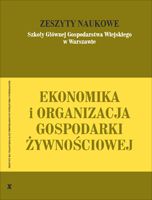Main Article Content
Article Details
ALTAVILLA C., 2008: The (UN-) stable relationship between the exchange rate and its fundamentals. Applied Economics Letters 15 (7), 539-544. (Crossref)
BAHMANI-OSKOOEE M., KUTAN A.M., ZHOU S., 2008: Do real exchange rates follow a non-linear mean-reverting process in developing countries? Southern Economic Journal, vol. 74 (4), 1049-1062. (Crossref)
BYERLEE D., SAIN G., 1986: Food pricing policy in developing countries: Bias against agriculture or for urban consumers? American Journal of Agricultural Economics, 68(4). (Crossref)
CZYŻEWSKI A., KUŁYK P., 2010: Relacje między otoczeniem makroekonomicznym a rolnictwem w krajach wysoko rozwiniętych i w Polsce w latach 1991-2008, Ekonomista 2.
CZYŻEWSKI A., POCZTA A., WAWRZYNIAK Ł., 2006: Interesy europejskiego rolnictwa w świetle globalnych uwarunkowań polityki gospodarczej, Ekonomista 3.
KANNAPIRAN CH.A., 2000: Commodity price stabilization: macroeconomic impacts and policy options. Agricultural Economics 23, 17-30. (Crossref)
KUTAN A.M., ZHOU S., 2008: The Enlargement of the European Union and the Behavior of Real Exchange Rates, Review of Development Economics 12(3), 550-561. (Crossref)
LEON H., NAJARIAN S., 2005: Asymmetric adjustment and nonlinear dynamics in real exchange rates. International Journal of Finance and Economics, no 10, 15-39. (Crossref)
MACDONALD R., RICCI L.A., 2007: Real exchange rates, imperfect substitutability, and imperfect competition, Journal of Macroeconomics, 29(4), 639-664. (Crossref)
SCHIFF M., VALDES A., 1998: Agriculture and the Macroeconomy, Policy Research Working Paper, The World Bank, Washington. (Crossref)
TAYLOR A.M., TAYLOR M.P., 2004: The purchasing power parity debate, Journal of Economic Perspective, no. 18, 135-158. (Crossref)
TAYLOR D.S., PHILLIPS T.P., 1991: Food-pricing policy in developing countries: Further evidence on cereal producer prices, American Journal of Agricultural Economics, 73(4). (Crossref)
VALDES E.A., 1973: Trade Policy and Its Effect on the External Agricultural Trade of Chile 1945-1965. American Journal of Agricultural Economics, 55(2), 154-211. (Crossref)
ANDERSON K., MARTIN W., VAN DER MENBRUGGHE D., 2006: Distortions to World Trade: Impacts on Agricultural Markets and Farm Incomes, Review of Agricultural Economics 28(2). (Crossref)
www.stats.oecd.org/wbes/
Downloads
- Andrzej Czyżewski, Bazyli Czyżewski, Adam Majchrzak, Absolute land rent – a retrospective and modern approach , Zeszyty Naukowe SGGW - Ekonomika i Organizacja Gospodarki Żywnościowej: No. 124 (2018)
- Piotr Kułyk, Mariola Michałowska, Price and readiness to pay for specific ecological products on the example of the inhabitants of the Lubuskie Voivodeship , Zeszyty Naukowe SGGW - Ekonomika i Organizacja Gospodarki Żywnościowej: No. 125 (2019)
- Andrzej Czyżewski, Ryszard Kata, Anna Matuszczak, The stabilizing effect of domestic and EU budget spending on Polish agriculture – an attempt to quantify , Zeszyty Naukowe SGGW - Ekonomika i Organizacja Gospodarki Żywnościowej: No. 125 (2019)
- Andrzej Czyżewski, Anna Matuszczak, Dilemmas of the agrarian question in the panorama of history , Zeszyty Naukowe SGGW - Ekonomika i Organizacja Gospodarki Żywnościowej: No. 90 (2011)
- Piotr Kułyk, Mariola Michałowska, The status of development of organic farming in Poland in the years 2004–2014 , Zeszyty Naukowe SGGW - Ekonomika i Organizacja Gospodarki Żywnościowej: No. 113 (2016)
- Andrzej Czyżewski, Katarzyna Smędzik, Impact of income tax on the economic situation of individual farms in the area of intensive agriculture (simulation for FADN farms of the county gostyński) , Zeszyty Naukowe SGGW - Ekonomika i Organizacja Gospodarki Żywnościowej: No. 92 (2011)





